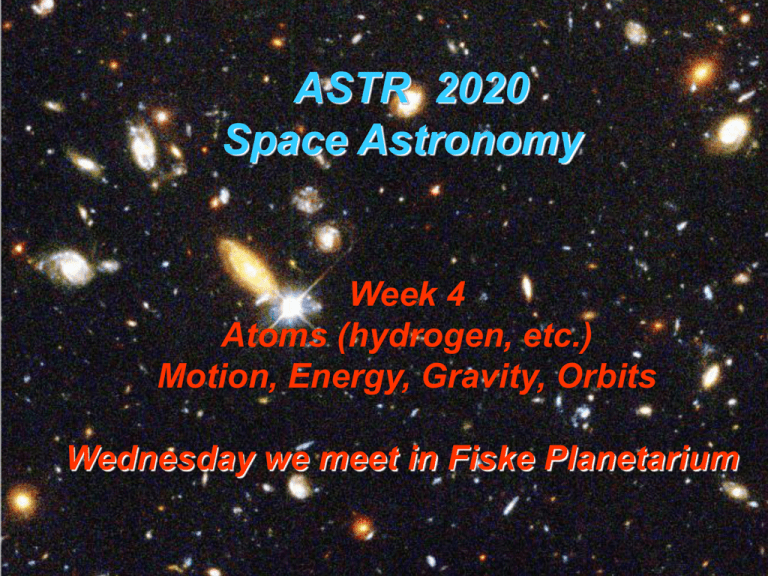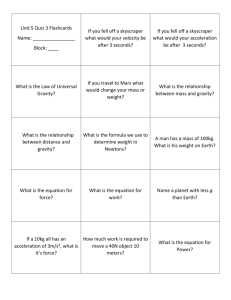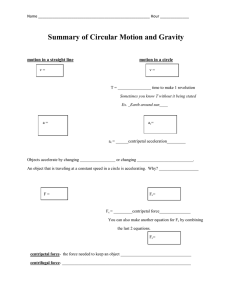ASTR 2020 Space Astronomy Week 4 Atoms (hydrogen, etc.)
advertisement

ASTR 2020
Space Astronomy
Week 4
Atoms (hydrogen, etc.)
Motion, Energy, Gravity, Orbits
Wednesday we meet in Fiske Planetarium
Why do atoms only emit certain
frequencies & wavelengths (spectral lines)?
Wave nature of matter:
momentum: p = mV = h/h/p
E = hf = h
Hydrogen spectrum:
g
b
a
b
Balmer
= R [ 1/nl2 – 1 /nu2]
R = 3.288 x 1015 Hz
Lyman
13.6 eV
a
Spectrum of hydrogen
13.6 eV = 912 Angstroms
10-18
Lyman lines
-3
Balmer lines
Wavelength (1 / photon energy)
Visual
Ultraviolet (UV)
Clicker Question
You observe the 6563 Angstrom spectral line of
atomic hydrogen from a galaxy. But, the
wavelength is measured to be
7,000 Angstroms…. What do you conclude?
A.
B.
C.
D.
E.
You have made a bad measurement error
The galaxy is moving toward you
The galaxy is moving away from you
The galaxy is located behind a cloud
The galaxy is moving at right angles to your line-of-sight
Outline: Gravity and Orbits
- Laws of Motion (Newton’s mechanics)
position, velocity, acceleration
mass, inertia, force, centrifugal force
- The inverse square law: Newton’s law of gravity
falling apples, and the moon
- Escape speed velocity needed to escape
- Orbits
balance between gravity and centrifugal force
- Kepler’s Laws of planetary motions
Motion
- Velocity (or speed):
V = [change in position] / [ time interval]
Example: Car moving. Covers 100 meters in 60 seconds
100 m = 104 cm, V = 104 / 60 = 166 cm/sec = 1.67 m/sec
= 65 ft/sec
= 44.7 mi/hr
- Acceleration:
a = [change in velocity] / [time interval]
Example: Drop a rock in Earth’s gravity ….
Speed increases by 980 cm/sec every second
(until air resistance sets in)
a = 980 cm s-2 (= 32 ft sec-2)
Mass, inertia, force, centrifugal force
- Mass, M: a measure of the amount of material
Example:
Mo = Mass of the Sun = 2 x 1033 grams
Mearth = Mass of the Earth = 6 x 1027 grams
Weight = the downward force a given mass exerts
in the Earth’s gravitational field:
Note: The acceleration of gravity at the Earth’s surface is
a = 980 cm s-2
g = 980 cm s-2
This is used so often we call it little ‘g’
acceleration at Earth’s surface
- Force = [mass] x [acceleration]
Weight = m g
F = ma
Forces
- Acceleration in presence of a force, F
a=F/m
- The four (known) fundamental Forces:
- Gravity (planets, stars, galaxies, …)
FG = - GmM / r2
- Electro-magnetism (atoms, molecules)
FEM = - q1q2 / r2 + q1 VxB / c
Isaac Newton
- Strong nuclear force (binds atomic nuclei)
- Weak nuclear force (radioactive decay, binds electrons to protons)
Gravity
Falling objects on Earth
most motions in astronomy
F = G Mm / r2
inverse square law!
Force pulls together objects with MASS
(mass has TWO roles - inertia AND creating gravity)
Force is weaker when the distance between them is greater
Force is stronger when the distance between them is smaller
This formulation of FORCE predicts motions of planets
accurately!
Mass, inertia, force, centrifugal force
- Inertia, M: a measure of the resistance to a force
In a vacuum (space) object in motion stay in motion
those at rest, stay at rest (unless there is a force).
- Centrifugal Force - actually a consequence of inertia
When tethered to a string, a rock is forced by the
string to move in a circle … but inertia wants to
make it move in a straight line. The resulting
force on the string is:
Fcent = [mass] x [ Velocity2] / [ radius ]
Fcent = mV2 / r
Example: m = 100 g, radius r = 100 cm, velocity = 100 cm/sec
F = 100 1002 / 100 = 104 (g cm sec-2)
Wednesday, 3 Feb: Fiske Session
- Visualize artificial satellites in orbit around Earth
Retrograde motion, Earth view of Solar eclipse
Spacs Station annimation
- Planetary motion
Epicycles of Ptolemy vs. orbits of Copernicus
- Tour of the Solar System
rocky planets (Mercury, Venus, Earth, Mars)
gas giants (Jupiter, Saturn)
ice giants (Uranus, neptune)
moons (Moon, Jovian, and Saturnian systems)
minor planets (main-belt asteroids)
dwarf planets (Pluto, Senda, …)
Kuiper-Belt Objects (KBOs)
Comets
Orbits:
Balance of opposing forces
Gravity <=> Centrifugal force
G M m / R2 =
m V2orbit / R
Solve for Vorbit:
M
m
Vorbit = (GM / R)1/2
Newton’s constant:
Vorbit
G = 6.67 x 10-8 c.g.s.
Reaching Orbit:
Vorbit = {GM / (R+H)}1/2
Mearth ~ 5.97 x 1027 g
G = 6.67 x 10-8 c.g.s.
R = 6,371 km
H = 300 km
Vorbit = {[6.67 x 10-8][5.97 x 1027 g]/[6.371e8 +3e7]}1/2
= 7.73 x 105 cm/sec = 7.73 km/s
Rockets: Tsiolkovsky’s equn.
V = Vejecta ln (Minitial/Mfinal)
M
Minitial = Mfinal exp (Vorbit / Vejecta)
~ Mfinal exp (7.7/3) ~ 13 Mfinal
Vorbit
De Laval Nozzle:
Hydrazine: N2H4
Vejecta ~ 1.7 - 2.9 km/s
Liquid: O2 + H2
Vejecta ~ 2.9 - 4.5 km/s
Solid:
Vejecta ~ 2.1 - 3.2 km/s
Echo (1960 - 1964)
Telstar-1 (1962)
Relay 1
Andover, Main
Crawford Hill
A. Penzias
R. W. Wilson

